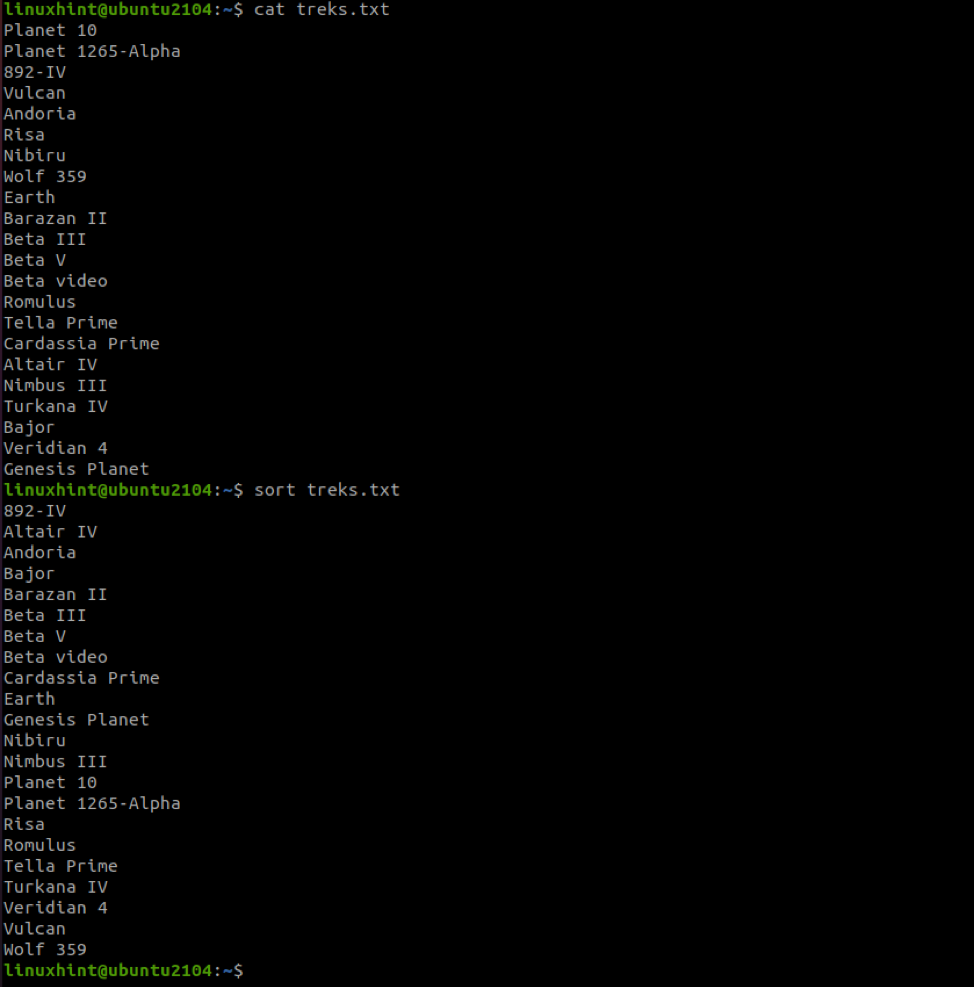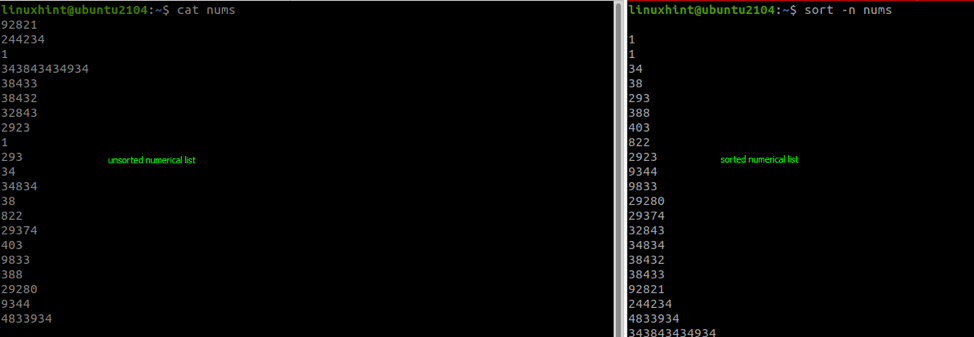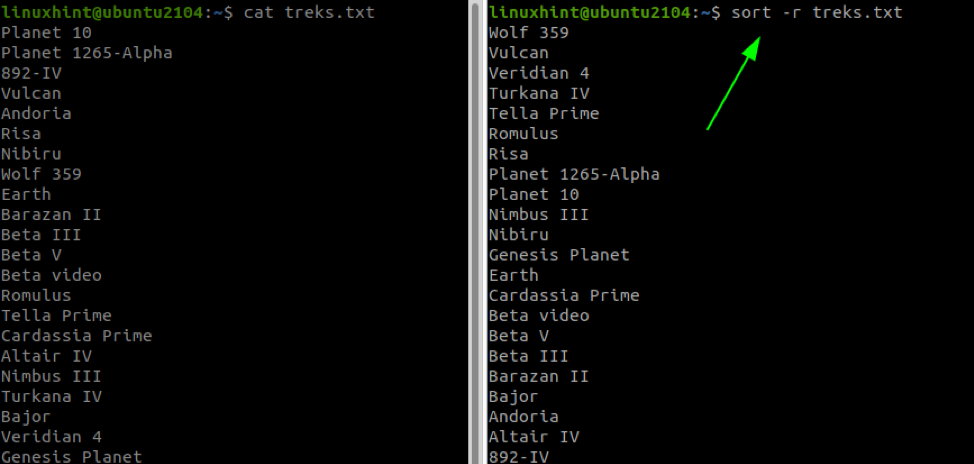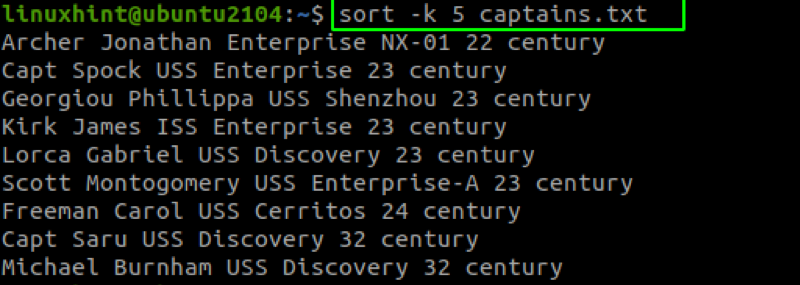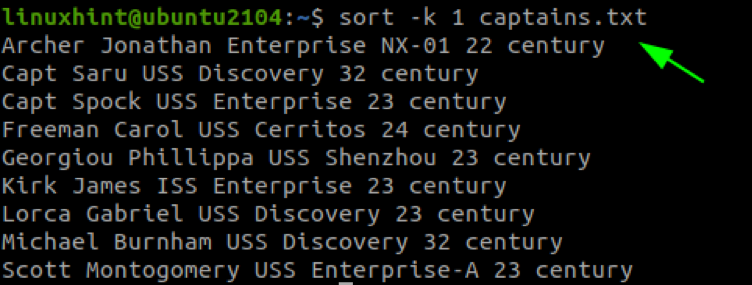- 10 Useful Examples of the Sort Command in Linux
- Sort command in Linux
- Examples of the sort command
- 1. Sort in alphabetical order
- 2. Sort on numerical value [option -n]
- 3. Sort in reverse order [option -r]
- 4. Random sort [option -R]
- 5. Sort by months [option -M]
- 6. Save the sorted results to another file
- 7. Sort Specific Column [option -k]
- 8. Sort and remove duplicates [option -u]
- 9. Ignore case while sorting [option -f]
- 10. Sort by human numeric values [option -h]
- How to Sort in Linux Bash by Column
- Basic Usage
- Sort Command Options
- How to Sort In Linux Bash By Numerical Values
- How to Sort In Linux Bash By Reverse Order
- How to Sort In Linux Bash by Column
- How to Save Sort Output to a File
- Conclusion
- About the author
- John Otieno
10 Useful Examples of the Sort Command in Linux
Sort command in Linux is used for sorting the contents of the text files. This tutorial shows you some basic examples of the sort command.
Sort command in Linux
The sort command arranges text lines in useful ways. This simple tool can help you quickly sort information from the command line.
You should note a few thing:
- When you use sort without any options, the default rules are enforced. It helps to understand the default rules to avoid unexpected outcomes.
- When using sort, your original data is safe. The results of your input are displayed on the command line only. However, you can specify output to a separate file if you wish. More on that later.
- Sort was originally designed for use with ASCII characters. I did not test for this, but it is possible that different encodings may produce unexpected results.
The default rules in the sort command
These are the default rules when using sort. The first few examples will clarify how these priorties are managed. Then we will look at specialized options.
Examples of the sort command
Let me show you some examples of sort command that you can use in various situations.
1. Sort in alphabetical order
The default sort command makes it easy to view information in alphabetical order. No options are necessary and even with mixed-case entries, A-Z sorting works as expected.
I am going to use a sample text file named filename.txt and if you view the content of the file, this is what you’ll see:
MX Linux Manjaro Mint elementary UbuntuNow if you use sort command on it:
Here’s the alphabetically sorted output:
elementary Manjaro Mint MX Linux Ubuntu2. Sort on numerical value [option -n]
Let’s take the same list we used for the previous example and sort in numerical order. In case you were wondering, the list reflects the most popular Linux distributions (July, 2019) according to distrowatch.com.
I will modify the contents of the file so that the items are numbered, but out of order as shown below.
1. MX Linux 4. elementary 2. Manjaro 5. Ubuntu 3. MintAfter sorting, the result is:
1. MX Linux 2. Manjaro 3. Mint 4. elementary 5. UbuntuLooks good, right? Can you rely on this method to arrange your data accurately, though? Probably not. Let’s look at another example to find out why.
1 5 10 3 5 2 60 23 432 21Now, if I use the sort command without any options, here’s what I get:
1 10 2 21 23 3 432 5 5 60NOTE: Numbers are sorted by their leading characters only.
When you add the -n option, the numerical value of the string is now being evaluated rather than only the first character. Now, you can see below that our list is properly sorted.
Now you’ll have the correctly sorted output:
1 2 3 5 5 10 21 23 60 4323. Sort in reverse order [option -r]
For this one, I am going to use our distro list again. The reverse function is self-explanatory. It will reverse the order of whatever content you have in your file.
And here you have the output text in reverse order:
5. Ubuntu 4. elementary 3. Mint 2. Manjaro 1. MX Linux4. Random sort [option -R]
If you accidentally mashed your shift key while attempting the reverse function, you might have gotten some strange results. -R rearranges output in randomized order.
Here’s the randomly sorted output:
4. elementary 1. MX Linux 2. Manjaro 5. Ubuntu 3. Mint5. Sort by months [option -M]
Sort also has built in functionality to arrange by month. It recognizes several formats based on locale-specific information. I tried to demonstrate some unqiue tests to show that it will arrange by date-day, but not year. Month abbreviations display before full-names.
Here is the sample text file in this example:
March Feb February April August July June November October December May September 1 4 3 6 01/05/19 01/10/19 02/06/18Let’s sort it by months using the -M option:
Here’s the output you’ll see:
01/05/19 01/10/19 02/06/18 1 3 4 6 Jan Feb February March April May June July August September October November December6. Save the sorted results to another file
As I mentioned earlier, sort does not change the original file by default. If you need to save the sorted content, it can be done.
For this example, I’ve created a new file where I want the sorted information to be printed and saved with the name filename_sorted.txt.
Caution: If you try to direct your sorted data to the same file, it will erase the contents of your file.
sort filename.txt -n > filename_sorted.txtIf you use cat command on the output file, this will be its contents:
1. MX Linux 2. Manjaro 3. Mint 4. elementary 5. Ubuntu7. Sort Specific Column [option -k]
If you have a table in your file, you can use the -k option to specify which column to sort. I added some arbitrary numbers as a third column and will display the output sorted by each column. I’ve included several examples to show the variety of output possible. Options are added following the column number.
1. MX Linux 100 2. Manjaro 400 3. Mint 300 4. elementary 500 5. Ubuntu 200This will sort the text on the second column in alphabetical order:
4. elementary 500 2. Manjaro 400 3. Mint 300 1. MX Linux 100 5. Ubuntu 200This will sort the text by the numerals on the third column.
1. MX Linux 100 5. Ubuntu 200 3. Mint 300 2. Manjaro 400 4. elementary 500Same as the above command just that the sort order has been reversed.
4. elementary 500 2. Manjaro 400 3. Mint 300 5. Ubuntu 200 1. MX Linux 1008. Sort and remove duplicates [option -u]
If you have a file with potential duplicates, the -u option will make your life much easier. Remember that sort will not make changes to your original data file. I chose to create a new file with just the items that are duplicates. Below you’ll see the input and then the contents of each file after the command is run.
1. MX Linux 2. Manjaro 3. Mint 4. elementary 5. Ubuntu 1. MX Linux 2. Manjaro 3. Mint 4. elementary 5. Ubuntu 1. MX Linux 2. Manjaro 3. Mint 4. elementary 5. Ubuntusort filename.txt -u > filename_duplicates.txtHere’s the output files sorted and without duplicates.
1. MX Linux 2. Manjaro 3. Mint 4. elementary 5. Ubuntu 9. Ignore case while sorting [option -f]
Many modern distros running sort will implement ignore case by default. If yours does not, adding the -f option will produce the expected results.
Here’s the output where cases are ignored by the sort command:
alpha alPHa Alpha ALpha beta Beta BEta BETA10. Sort by human numeric values [option -h]
This option allows the comparison of alphanumeric values like 1k (i.e. 1000).
I hope this tutorial helped you get the basic usage of the sort command in Linux. Sort command is often used in conjugation with the uniq command in Linux for uniquely sorting text files.
If you have some cool sort trick, why not share it with us in the comment section?
How to Sort in Linux Bash by Column
The sort command available in Linux allows users to perform sorting operations on a file or an input. The sort command is handy when we want to get an ordered output of a file ascending, descending, or custom-defined sort order. By default, the sort command does not alter the original file unless the output is redirected back to the file.
This article covers how to use the sort command to perform sorting operations on specific columns in a file.
Basic Usage
The sort command is simple to use and very useful in daily Linux operations. The general syntax of the command is as:
The options you pass to the command modifies how the file is sorted and the specific conditions to sort the target file. You can omit the options to use the default sorting parameters.
By default, the sort command:
- Sorts the alphabets in ascending order.
- Letters come after numerical values
- Assigns higher precedence to lowercase letters than to uppercase letters.
For example, to sort a file without options:
Once we run the sort command against the file, we get the information sorted in alphabetical order (ascending).
NOTE: Numerical values take precedence as from the example above.
Sort Command Options
You can use the following options in conjunction with the raw command to modify how the values are sorted.
- -n – sorts in numerical values.
- -h – compares human-readable numbers such as 1k, 1G
- -R – sort in random order but group the identical keys.
- -r – sort the values in reverse (descending order).
- -o – save ouput to a file
- -c – check if the input file is sorted; do not sort if true.
- -u – show unique values only.
- -k – sort the data via a specific key (useful when sorting columnar data).
Those are some popular options you can tweak to get the best-sorted result. For more options, check the manual.
How to Sort In Linux Bash By Numerical Values
How to Sort In Linux Bash By Reverse Order
To sort input in reverse order, we use the -r flag. For example:
The command above will sort in ascending alphabetical order (numerical values first) and reverse order.
How to Sort In Linux Bash by Column
Sort allows us to sort a file by columns by using the -k option. Let us start by creating a file with more than one column. In sort, we separate a column by a single space.
In the example file below, we have six columns.
To sort the captains’ file above by their century, we can specify the -k followed by the column number as:
Once we specify the column to sort the data, the sort command will try to sort the values in ascending order. In the example above, the command sorts the values from the earliest century to the latest.
To sort by the first name, set the sort column as 1:
How to Save Sort Output to a File
To save the sorted output to a file, we can use the -o option as:
The command above will sort the captains.txt file by the 5 th column and save the result to the captains_century.txt file.
Conclusion
That is the end of this tutorial on the sort command in Linux. We covered the basics of using the sort command to get the most out of your sorted data. Feel free to explore how you can use the sort command.
About the author
John Otieno
My name is John and am a fellow geek like you. I am passionate about all things computers from Hardware, Operating systems to Programming. My dream is to share my knowledge with the world and help out fellow geeks. Follow my content by subscribing to LinuxHint mailing list


